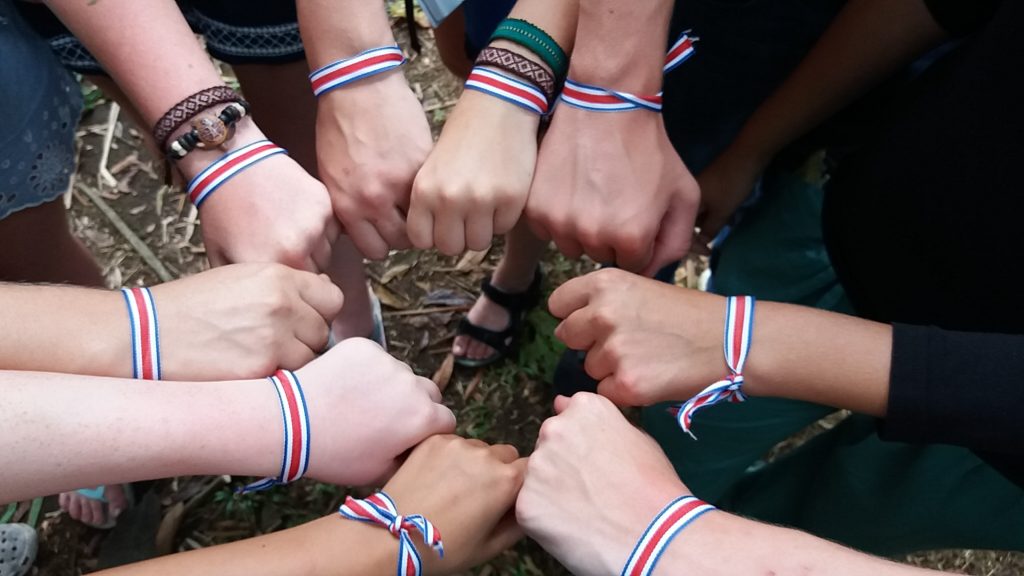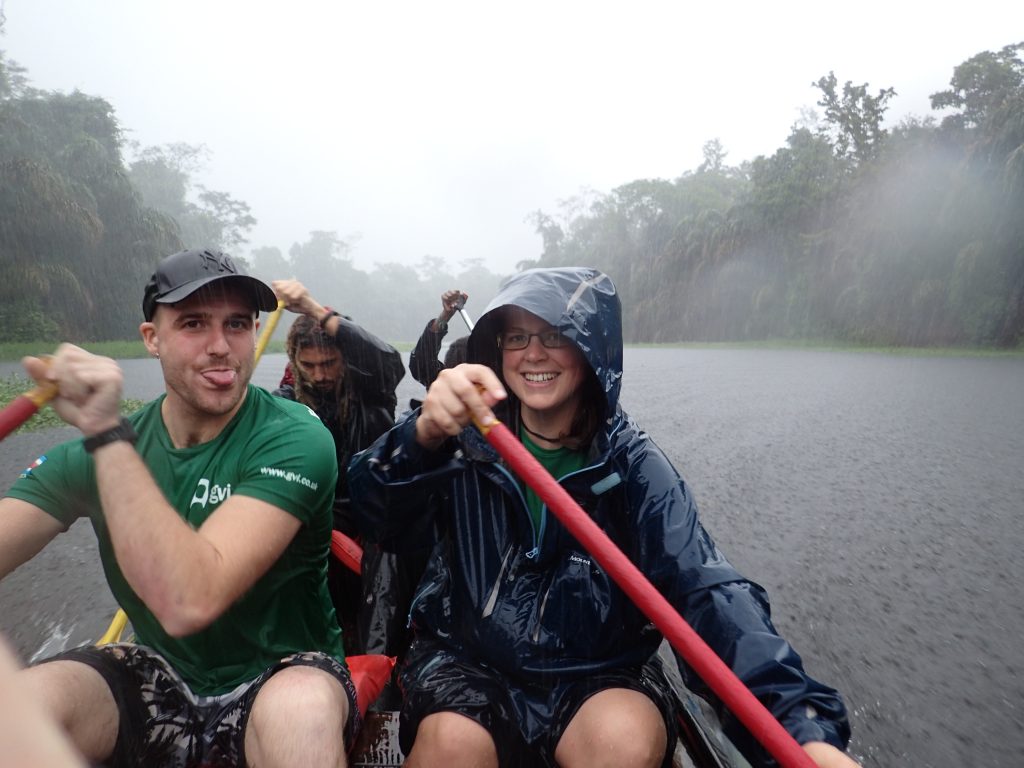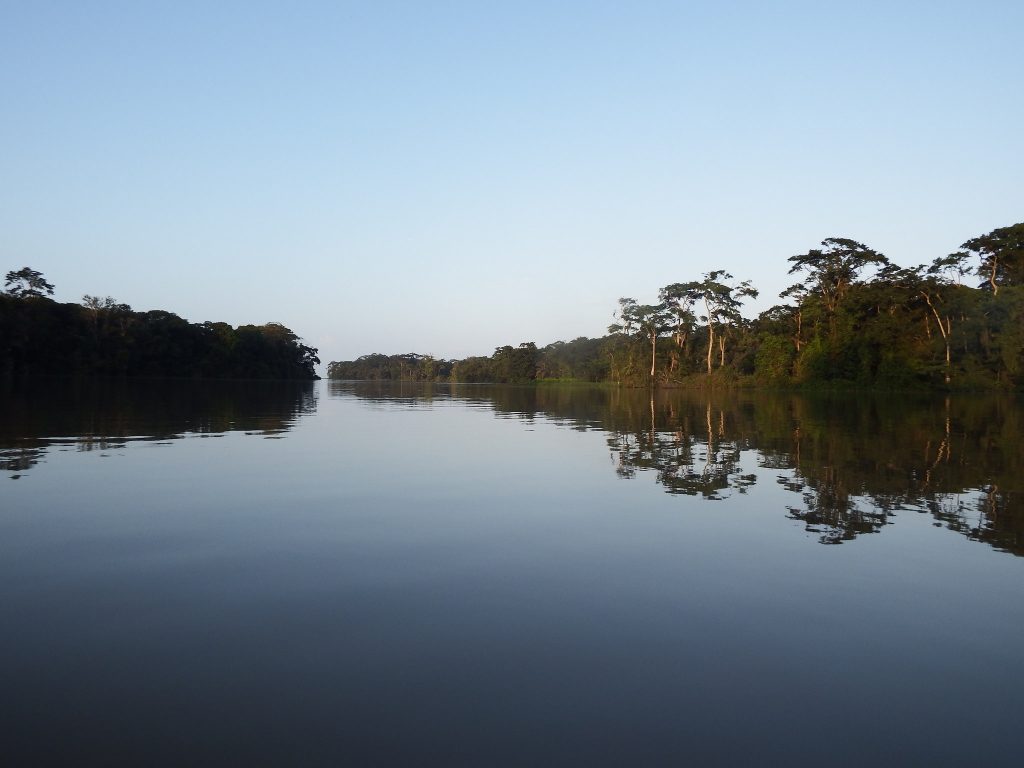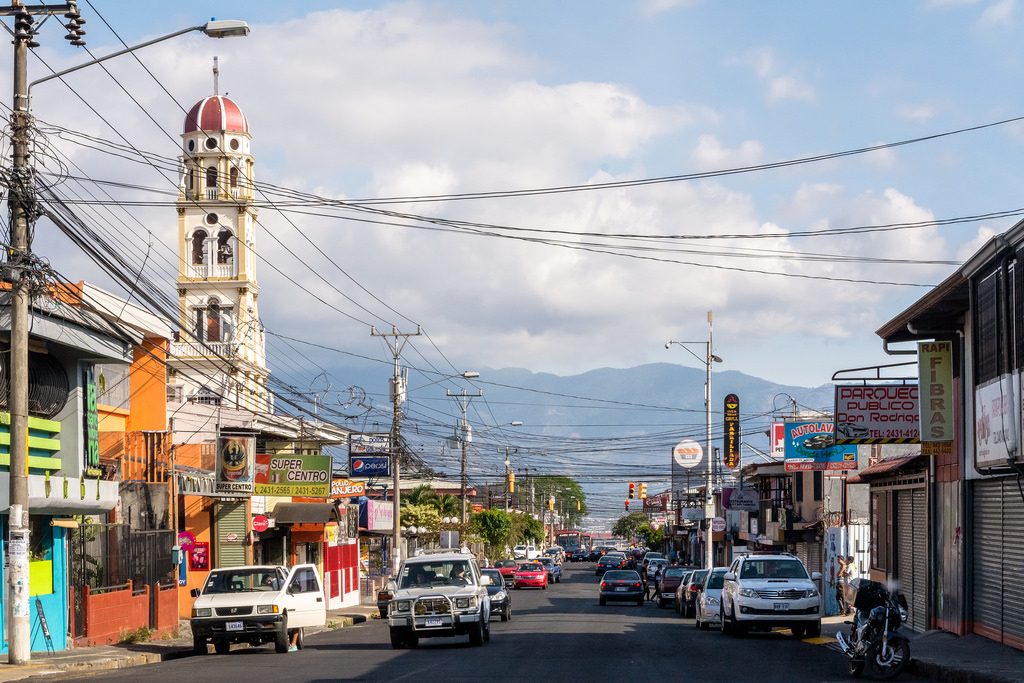Reptile and Amphibian Diversity Research in the Costa Rican Rainforest
- Experiences | Vol and Intern
-
Conservation Careers
- Kekoldi, Costa Rica
- Posted
2 weeks ago
-
Conservation Careers
Reptile and Amphibian Diversity Research in the Costa Rican Rainforest
- Experiences | Vol and Intern
-
Conservation Careers
- Kekoldi, Costa Rica
- Posted
2 weeks ago
-
Conservation Careers
Overview
Hike through the Costa Rican rainforest identifying reptile and amphibian species AND get career training from Conservation Careers!
Monitor the health of the Kekoldi Indigenous Reserve by recording sightings of reptiles and amphibians, as well as other species, along forest trails. By collecting data concerning jungle biodiversity you will be assisting local authorities with the management of the park and region, thereby contributing to United Nations Sustainable Development Goal #15, Life on Land.
Overview
Travel to the heart of the Kekoldi Indigenous Reserve, to assist the Costa Rican Ministry of the Environment, Energy and Telecommunications, MINAET by conducting biodiversity surveys of the area. Record sightings of reptiles and amphibians, as well as mammals and birds, identified as significant indicators of health and of importance for further research by MINAET. Some of these significant reptiles include the gorgeous eyelash palm pitviper and the always popular red-eyed tree frog.
From April to October, you can also get involved in research projects, concerning the main reptile we study at this base, sea turtles. In partnership with MINAET and the Sea Turtle Conservancy, you will join our staff and participants from around the world to conduct nightly beach surveys recording evidence of mother sea turtles and morning walks recording turtle nests.
Depending on the needs of our partners at the time, you might also have the opportunity to conduct jaguar research, monitoring camera traps and tracks on the beach, and bird research, travelling in the Kekoldi Indigenous Reserve identifying aquatic birds on the river banks and in the caponies.
The extensive training you will receive before heading out to conduct surveys as well as the practical experience and ongoing support you will gain in the field, could be used as springboard into a future career as a wildlife conservationist.
Due to the fact you will work in a national park, you will need special scientific permit to approve you for conducting research. Further permits are required for turtle and jaguar research. The permit for turtle research takes about one month to process, while the permit for conducting jaguar research takes about 2 to 3 months to process.
Highlights
- Observe unique Costa Rican amphibians and reptiles in their natural habitat.
- Visit an incredibly jaguar-dense area and one of the only locations in the world where jaguars are known to prey on adult sea turtles.
- Explore the rainforest by canoe and walk the pristine Caribbean beaches.
- Learn biodiversity survey techniques and gain real field experience.
- Undertake turtle nesting surveys and monitor nesting sites during turtle nesting season.
- Contribute to jaguar research by setting up and checking camera traps in the rainforest.
Our Award-winning Partner
Conservation Careers has teamed up with an award-winning, mission-driven organisation with a team of passionate experts across the globe who will make your experience a truly unforgettable one.
Founded in 1998, they run programs in 21 locations, in 13 countries around the world, each aligned to the 17 United Nations Sustainable Development Goals as well as the objectives of local partners. They welcome participants from all around the world and help facilitate their development into global citizens. This is how they achieve their mission of building a global network of people united by their passion to make a difference.
Their commitment to running high-quality sustainable development and experiential education programs has earned them recognition from numerous organizations such as Panthera, the Seychelles Parks & Gardens Authority, as well as Stanford, NYU, Duke, and Ohio State.
If you register your interest below, you’ll put you in touch with our partner to take the booking and to plan your trip!
To see all our Conservation Careers Internship opportunities, please click here.
Life on base
Unplug and get in touch with nature in Kekoldi Indigenous Reserve. Situated in the heart of the jungle, our base is the ideal location for those with a passion for wildlife conservation and adventure. During field work, you’ll hike the forest looking for signs of jungle cat species, migratory raptors, tropical birds, and a wide variety of primates, lizards and amphibians. You might even encounter more elusive animals like sloths and tamanduas. Morning patrols feature spectacular sunrises over the indigenous forest, and night walks reveal a star-filled sky. We also assist with turtle hatching sites on local beaches.
Your impact
All of our programs have short, mid and long-term objectives that fit with the United Nations Sustainable Development Goals or UN SDGs. This enables us to report on our collaborative impact across the world in a streamlined manner, measuring which UN SDGs we are making a substantial contribution to. Furthermore, this will help our local partners and communities measure and visualise their contribution to the UN SDGs.
Upon arrival to base, you will be educated about the history of the UN SDGs. You will learn about the specific goals of your location, the long-, mid- and short-term objectives, and also clarification of how your personal, shorter-term involvement contributes to these goals on a global level.
Our aim is to educate you on local and global issues, so that you continue to act as active global citizens after your program, helping to fulfil our mission of building a global network of people united by their passion to make a difference.
Rainforest Biodiversity Surveys
We assist MINAET with conducting a Biological Assessment Survey or BAS of the four major habitat types. We note a wide range of species on our surveys which are of interest to MINAET including the Rain Frog, Red-eyed Treefrog, two species of Toucan, Baird’s Tapir, Spider Monkey, Mantled Howler Monkey, White-lipped Peccary, Eyelash Palm Pitviper. Staff and participants walk a several marked path in the forest noting sighting, tracks, and vocalisations. Only species identified with 100% certainty can be recorded. The data is sent to MINAET who use a standardised methodology to monitor the condition of each trail over time. This helps them to understand the health of the local environment and whether their current conservation efforts are working.
Sea Turtle Research
We also assist the Sea Turtle Conservancy, or STC, with sea turtle research and protection, by using internationally recognised protocols during turtle nesting and hatching season, from around March to December each year. The STC patrols the northern stretch.
From April to October, a team walks the beach each night looking for nesting sea turtles.
Depending on the time of year, it is possible to do several walks without seeing a turtle, or see multiple ones in one night. When a turtle is encountered, different kinds of research activities might be carried out, depending on what stage of the nesting process she is in from emerging from the sea, selecting a nest site, digging a body pit, and digging her egg chamber to laying her eggs, covering her egg chamber, disguising her nest, or returning back to sea. This might include, checking for distinctive markings to see if she has been to the beach before and make a note for future researchers if she returns, tagging her flippers, measuring her carapace, counting her eggs, marking her nest, or checking for abnormalities in the mother turtle or eggs.
From April to November a team patrols the beach during the day to look for nests that were marked previously to determine whether any of the nests have hatched, been eroded by the sea, been attacked by predators like jaguars, or been poached by humans. This information is used to investigate whether any areas of the beach are more susceptible to nest loss. Depending on the season, we also take note of mother turtle tracks from the previous night.
Between June and December, hatched nests are excavated to determine hatchling success and survival rates, reason for losses in egg development, and determine the actual status of the nests including whether or not they were partially or fully poached.
Throughout the year our teams carry out beach cleans to ensure a good nesting place for mother turtles and an uninterrupted passage for hatchlings to make their way to the sea.
Jaguar Population and Turtle Predation Research
The jaguar is the only member of the Panthera or ‘big cat’ genus found in the the Western Hemisphere. The International Union for the Conservation of Nature, or IUCN, Red List has given the jaguar the status of being ‘near threatened’.
We assist MINAET with estimating the minimum number of jaguars using the coastal habitat, identifying the availability of prey species in the area, noting any changes in jaguar feeding behaviour, and determining whether the predation of marine turtles by jaguars is having an impact on the marine turtle populations. This helps the Costa Rican Ministry of Environment develop well-rounded and consistent conservation policies. To improve and expand our research, we collaborate with Panthera and Coastal Jaguar Conservation.
Direct observations of jaguars can be very difficult to achieve because of their elusive nature. Several projects of elusive species worldwide have turned to remote observation techniques in order to estimate population sizes, for species in which individuals are identifiable by markings, or relative abundance, for those species in which individuals are not identifiable. Camera trapping projects have been used to estimate tiger density within national parks in India and ocelot densities in the Pantanal region of South America to name a few. Other projects in Costa Rica such as the Tropical Ecology Assessment and Monitoring Network, or TEAM Initiative from Conservation International and Wildlife Conservation Society, or WCS, Jaguar Project in Corcovado National Park have also had success with camera trapping of jaguars. We started our jaguar camera trap program in 2006 and it has been constantly evolving ever since as new, more effective methodologies continue to be developed.
From February to November, our team walks a 15-mile stretch of the beach starting in the early morning to note jaguar tracks and check on permanent camera traps set up to ID new or known jaguars in the area. Permanent cameras are set up in areas of known jaguar activity in the vegetation lining the beach. A scent station might be included to halt the jaguar in their progress so that a clearer picture of their rosette pattern markings can be taken for use in identification. We also collect jaguar scat or faeces for use in jaguar feeding behaviour and genetic studies.
During turtle nesting season, from March to October, we also monitor the number of sea turtles preyed upon by jaguars. When a predated turtle is found we note the species of turtle, assign an identification number, and check for tags. We also record the time and location, biometric data, and a description of the style of predation. Killcams are set up on predated turtles to witness jaguar behavior as they return to the kill. In addition, data is collected on weather and beach conditions at specific areas.
Aquatic Bird Research
We also monitor 30 aquatic bird species identified by MINAET as important indicators of the ecological health of the National Park as a whole. These include exotic ave species like the neotropic cormorant, the rufescent tiger-heron, the cattle egret, the green ibis, and the amazon kingfisher. Early morning surveys are conducted on canoe along canals and last approximately 3 hours. Species are identified and specifics such as their sex and breeding behaviour are noted. The aim of this project is to help researchers and governmental authorities understand when and where resident species migrate to. It is generally believed that seasonal migration takes place within Costa Rica but details are lacking. It also helps MINAET with developing an accurate management plan. In addition, we collect information on all incidental species seen on the canals. Sightings of megafauna like endangered manatees are extremely important to MINAET as they provide evidence towards justifying the boundaries of the National Park and whether to extend them.
As such, the specific United Nations Sustainable Development Goal we work on is #15, Life On Land.
Exploration
Joining a program not only allows participants to collaborate with communities or work toward preserving unique ecosystems but it also offers plenty of opportunities to explore the surrounding area or travel further to see what other parts of the region have to offer.
Long term field staff are a great source of advice, and have helped us put together the following information on local travel options. Many decide to travel before or after their experience (subject to immigration restrictions), solidifying the lifetime friendships established on program. Please note that the below suggestions are not included in the program fee, and are for the individual to organise at their own expense.
Weekend Trips
Snorkelling
Cahuita National Park is home to the biggest and best-preserved coral reef in Costa Rica. Part of the park’s protected area extends into the ocean – offering up incredible marine life. Here you can spend time snorkelling, looking out for uncommon marine species.
San Jose
Spend the weekend in Costa Rica’s capital city, San Jose. You could visit one of the city’s many museums or parks, join a guided food and walking tour of the city, or spend time at Central Market – filled with food stalls where you can sample a range of traditional Costa Rican foods.
Tortuguero National Park
Head north up the coast to Tortuguero National Park, one of Costa Rica’s most beautiful national parks. The name “Tortuguero” can be translated as “land of the turtle”. The park is most well-known for its green turtle population, with leatherbacks and hawksbills frequenting its beaches. Very occasionally a loggerhead might pay a visit. Sea Turtle Conservancy, the world’s oldest sea turtle conservation organisation, is based in the park.
Trek to the top of Tortuguero Hill, an ancient dormant volcano. You’ll be rewarded with a magnificent view – stretching from the jungle to the shores of the Caribbean sea. You could also experience the wonders of the rainforest from a different perspective with a zipline canopy tour.
An hour’s motorboat ride away from Tortuguero National Park is the town of Tortuguero, where you can experience the laidback “Pura Vida” lifestyle Costa Rica is known for. Here you can practise your Spanish and taste some Costa Rican delicacies.
Puerto Viejo
Just south of the programme base, is one of the most popular beach destinations on the Caribbean coast of Costa Rica. This town is known for Punta Uva beach, where you’ll find kilometres of white sand lined with palm trees, excellent surfing conditions and popular eateries. The famously advanced surfing spot known as Salsa Brava can also be found here. And if you’re looking for something more off the beaten track, head to Manzanillo, a neighbouring beach town.
Head north up the coast to Tortuguero National Park, one of Costa Rica’s most beautiful national parks. The name “Tortuguero” can be transl…
Organise an adrenaline-inducing journey over the rapids of the Pacuare River. The beautiful Turrialba region is known for its variety of outdoor activities. Being a valley that is crossed by various rivers, it’s especially known for its white-water rafting. The Pacuare river is world-renowned for being one of the best white-water rafting rivers. If you’re looking to float around, you can choose one of the more peaceful rivers, like the Pejibaye or the Reventazón river. While visiting the area it is easy to combine rafting with other activities like canyoning, night hikes and lake kayaking.
Local Adventures
Sloth Sanctuary
Book a tour of the Sloth Sanctuary of Costa Rica
There are endless opportunities around the base for wildlife photography. Staff and other participants often bring camera equipment with them – and spend their free time in the coconut tree area or on the beach, working on their photography and videography skills.
There’s a small library with lots of textbooks and flashcards for species study and identification practice, as well as educational materials about conservation threats and wildlife biology.
Physical activities
Frisbee, volleyball, yoga and pretty much any exercise can be done on the beach. There’s also a ping-pong table on base.
An advantage of our remote location is the lack of air pollution. This means that on a clear night, you can look up and enjoy a sky filled with stars. On some nights, you can even see the Milky Way. Storm watching is amazing – lightning lights up the forest and on night walks you can watch it flash over the ocean.
Games night
Card games are a part of the culture on base. Whether you’re already a master or have never played before, be sure to join a game night – or even host your own.
We’ve added many good books to our on-base library over the years. Pick one that looks interesting, find a spot overlooking the ocean and lose yourself in the pages.
Movie nights
Join staff and other participants for movie nights. We set up the projector and make some popcorn. Do you like your popcorn sweet or salty?
Birding or frogging
Our base is home to a variety of bird and frog species. Fellow participants are likely to be just as passionate about conservation and the natural world as you are, so get a group together and find some birds. If it’s been raining, find some frogs too.
Further travels
Water sports
Surfing, windsurfing and kayaking are just some of the many water sports you can enjoy on either of Costa Rica’s two coasts.
Coffee and chocolate farms
Learn more about how the raw products of these everyday treats are produced at one of Costa Rica’s many coffee and chocolate farms.
Explore the natural wonders of the Talamanca mountain range, including the UNESCO-protected La Amistad International Park. Hiring a guide is necessary as the Talamancas aren’t easily accessible if you’re unsure of your route. While in the area, learn about the history and customs of the Naso, Bribri and Ngöbe-Buglé people, who have lived in the region for centuries.
Travel to a few of Costa Rica’s many other National Parks, like Manuel Antonio Park, Corcovado National Park, Monteverde Cloud Forest Reserve (where you can visit the hummingbird gallery), or Braulio Carrillo National Park.
Cultural immersion
Engaging intimately with a new context teaches global awareness, adaptability and critical thinking – skills highly valued in the modern marketplace. Local and cultural immersion is encouraged on all our programs around the world, and will also be one of the most enjoyable aspects of your experience. Luckily, there are many different activities that you can get involved in during your free time, or before and after your program.
On our community programs, the focus is on cultural topics, while on marine or wildlife programs the emphasis is more on the environmental element. Use your evenings and weekends to explore topics like local cuisine and religion, or how sustainable development challenges are affecting local contexts.
Cahuita town
The Kekoldi Indigenous Reserve (KIR) is home to the Bribri tribe, one of several indigenous groups that live in Costa Rica. Participants have the opportunity to work closely with the KIR’s community members and contribute to long-term sustainable conservation programs. You’ll also get a chance to spend time within the community, learning about the tribe’s culture and history, their use of medicinal plants, and their practice of traditional chocolate making. At the same time, it is an invaluable opportunity to gain insights and perspective on Costa Rica’s history, where Afro-Caribbean and Latin American cultures and heritages converge in complex and historically significant ways.
Experiences
Exclusive local experiences:
- Cook traditional cuisine with local experts.
- Learn how to weave your own hammock.
- Reflection hike through the lush rainforest.
- Waterfall hike through Kekoldi Indigenous Reserve.
- Stargaze and learn about the constellations.
- Wildlife photography in remote habitats.
- Chocolate-making on a working cacao farm.
- Panoramic views from a canopy tower.
BONUS! Conservation Career Kick-Starter online training programme (worth £295)
Do you want to spend your career helping wildlife to flourish, but are feeling a little lost, confused or disillusioned?
Start your career in wildlife conservation with a unique programme of training, support community & jobs from Conservation Careers!
The Conservation Career Kick-Starter is a proven step-by-step system to get clear, get ready, and get hired as a professional conservationist.
Whether you’re at university and planning your next steps, a graduate in the job hunt or working in an unrelated job but interested to switch into conservation, this course is designed to help you.
After going through the course, you’ll have created a personal career plan which will give you confidence in your job hunt and will make everything quicker, simpler and more fun!
All you need to do is register your interest in the project below, and if you choose to make a booking we’ll save a place for you on the Kick-Starter when you get back from your placement.
Included with the Kick-Starter is a year’s full-access to the world’s biggest conservation job board with over 15,000 jobs, plus access to our private online support community, CC Pro.
Duration, dates and costs
Register your interest below to find out about upcoming start dates, durations and costs.
What’s included
Increasing Employability: Pre Departure Program Training
Our programs are not only life-changing experiences but are also designed to help participants increase their employability. We have developed a curriculum to be completed prior to arrival in the country in order to ensure that more time is dedicated to program work once you commence your volunteer program.
Eight weeks prior to your start date, you will complete the following online courses in preparation for your in-country program:
PRE-DEPARTURE ORIENTATION (1 hour)
PROGRAM SPECIFIC TRAINING (1 – 5 hours)
OPTIONAL: WILDLIFE CONSERVATION COURSE (10 – 15 hours)
In order to obtain a certificate for the Wildlife Conservation course which is endorsed by the University of Richmond and UNC Charlotte, you will need to complete quizzes & assignments and will be given 4 weeks post program to submit your work.
If you are looking to travel in less than 8 weeks from now, you will still complete the course however this will be done in country and all content will need to be downloaded before arrival.
Health & Hygiene
The work we contribute to across the globe remains important and new measures allow our participants to continue to join our programs and continue impacting positively on their world and the communities we work with. Changes to our existing protocols have been made by our health and hygiene team to strengthen our health and hygiene protocols and ensure that international standard safeguards are in place to protect our participants, staff and host communities. Please inquire for more information on the protocols.


















